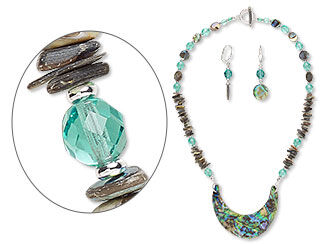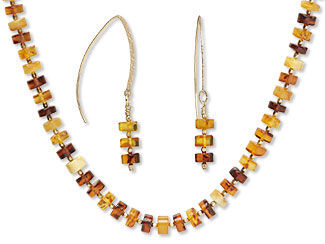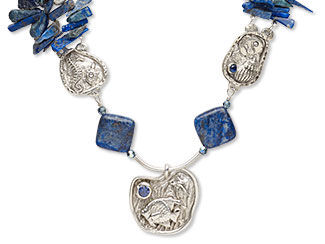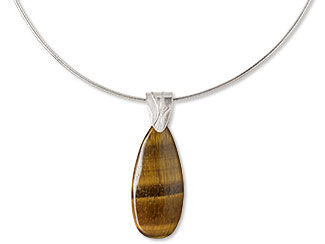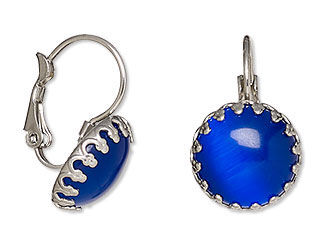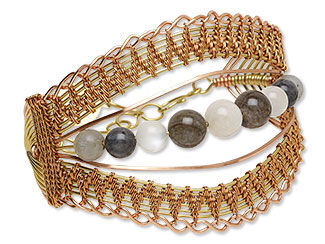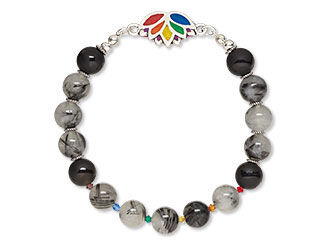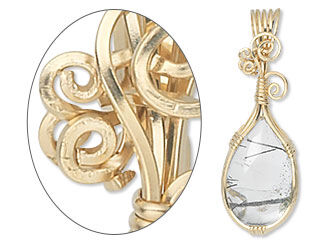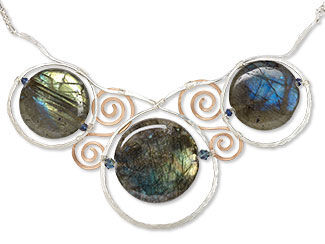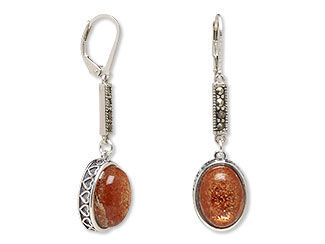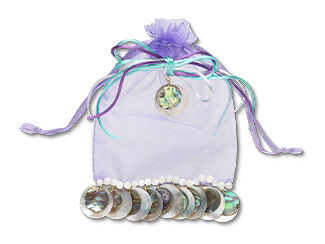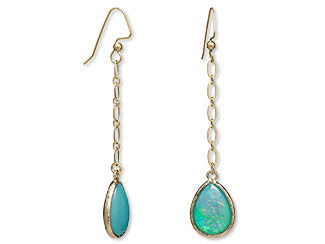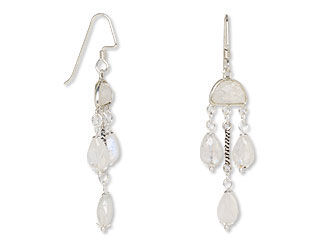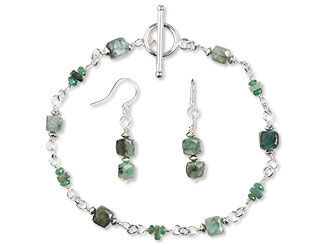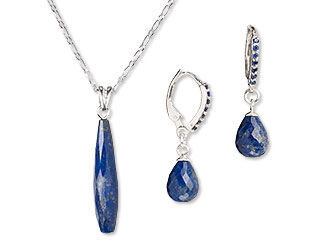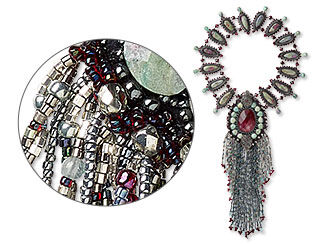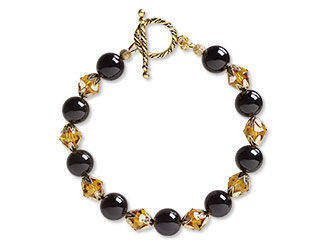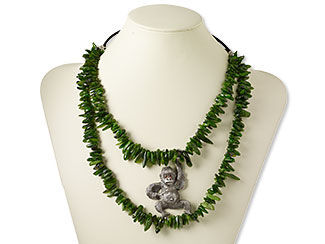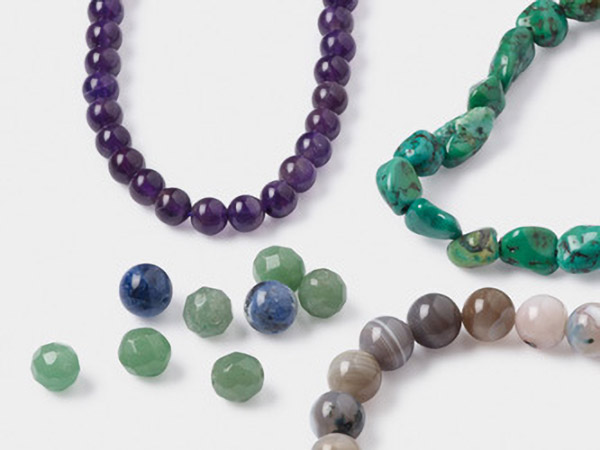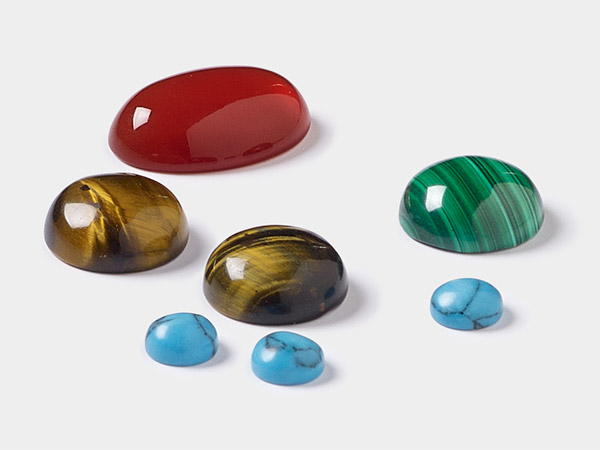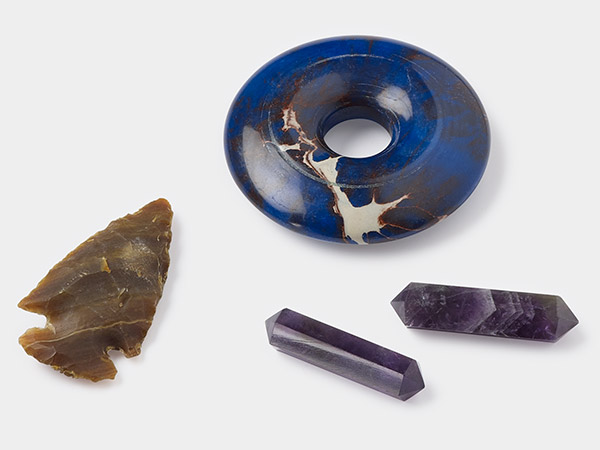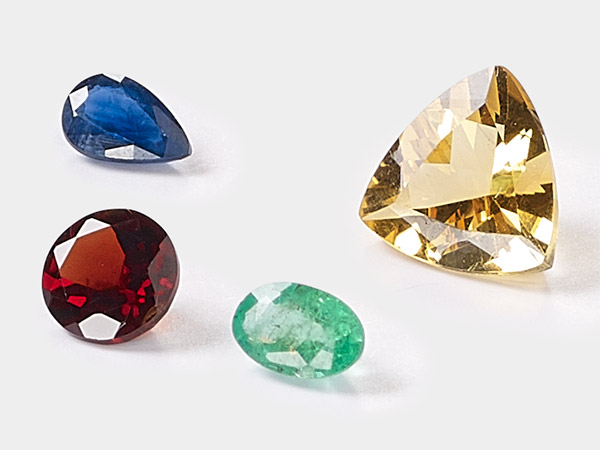Special Effects in Jewelry-Making Materials
Long before George Lucas was creating light sabers, special effects existed naturally in gemstones and other jewelry-making materials. The colorful fire in an opal, the shimmering asterisk of a star sapphire, the dark threads in tourmalinated quartz—these optical effects make their gemstone materials even more beautiful and valuable.
These special effects have specific names in gemology. Some of them are caused by the way light acts within the gemstone ("phenomena"), while different effects come from other materials embedded within the stone ("inclusions"). Gemologists use the word "inclusion" as a label for foreign matter or structural irregularities, in the makeup of a specific gemstone. Inclusions can be crystals of other materials, enclosed bubbles of liquids or gasses, organic materials and other differences.
Among transparent gemstones—especially the cardinal stones of ruby, sapphire and emerald—inclusions are not only proof of naturalness, but certain forms add rarity and value to a stone. Skillful lapidaries use sophisticated cutting and polishing techniques to enhance these optical effects in mined materials, while organic gemstones may require light oiling to maintain their appearance and value.
Here are some common gemstone inclusions and phenomena, including a brief explanation of what each is, how it looks to the human eye, how it can add value to a gemstone and what gemstones each type is likely to appear in.
Chatoyancy
Chatoyancy (sha-TOY-en-see) comes from the French phrase for "eye of the cat," and jewelry makers will frequently see this special effect in materials named after felines: cat's eye quartz, tigereye and others. Chatoyancy is an inclusion of fiber-like structures within the stone and tends to make a stone opaque. This "cat's eye" effect—called "silk" in the gemstone trade—is caused when a swath of fibrous rutiles line up in a stone, creating the illusion of an eye in the stone.
Gemstones displaying a high level of chatoyancy are usually carved in smooth shapes (round/oval beads or cabochons), as faceting decreases the strength of the effect.
Commonly Seen In:
- Apatite
- Beryl (especially aquamarine)
- Cat's eye quartz
- Chrysoberyl
- Rainbow obsidian
- Tigereye and tiger iron
- Tourmaline
- White, peach and grey moonstone
- Also seen in fiber optic glass (called "cat's eye glass'' because of its visual similarity to cat's eye quartz)
Asterism
Asterism is derived from the Greek word for "star." It is a specific form of chatoyancy, exhibiting a luminous multi-rayed star moving across the surface of the stone. Six-rayed stars are the most common form, although both four-, eight- and twelve-rayed stones also occur. This "star" is created by the presence of dense inclusions of tiny rutile fibers aligned perpendicular to the rays of the star displayed on the surface and create a range of opacity in any stone in which they are present.
The sister corundums—red ruby and the multiple colors of sapphire—are the most famous gemstones known to display asterism. These gemstones are frequently cut into a cabochon or other curved shape to enhance the star inclusion. Many are even named (the Star of Asia, the Black Star of Queensland, the DeLong Star Ruby, etc.) and have been donated to museums where they can be studied and appreciated.
Commonly Seen In:
- Chrysoberyl
- Corundum (ruby and sapphire)
- Diopside
- Garnet
- Moonstone (rarely)
- Rose quartz
- Spinel
Rutilated, Tourmalinated and Dendritic
Rutile is a black or reddish-brown mineral consisting of titanium dioxide, typically occurring as needle-like crystals that can appear golden to the eye. This mineral can bend light more than most other gemstone materials, which is why chatoyancy and asterism occur when the rutile inclusions align in various ways. When rutiles do not align, the transparency of the host stone is not affected, and the rutiles appear as hair-thin golden needles within the stone. The host stone is usually clear quartz (called "rutilated quartz"), however, rutiles can also appear in prehnite and other gemstones.
The needle-shaped inclusion type can include materials other than rutile. Some gemstones will contain epidote, actinolite, tourmaline or other stones. When black tourmaline needle inclusions appear in clear quartz, the stone is called tourmalinated quartz.
Another common and popular form is dendritic—"tree-like"—inclusions in clear quartz or milky chalcedony. Dendritic quartz (also called dendritic opal or dendritic agate) features branching inclusions of iron, manganese, hematite or other materials. The dendrites resemble the growth of ferns or other plant-like structures, giving the stones their names. Jewelry makers can also use dendritic jasper, a more easily found and less exclusive gemstone material.
Commonly Seen In:
Iridescence, Labradorescence and Schiller
Iridescence (eer-ih-DESS-ens), from the Greek word for "rainbow," is an optical effect where colors on the surface of an item appear to change with the angle from which it's viewed.
Iridescence creates the colors floating on the surface of oil slicks in a parking lot, or soap bubbles in the sunlight. It comes from multiple reflections within two or more transparent or semi-transparent layers. Light enters the top layer and "bounces" around between the layers. Iridescence can include a variety of rainbow effects in gemstones, including schiller (SHIL-er) and labradorescence (lab-rah-dor-ESS-ens).
Dark iridescence can also be seen in non-gemstone materials such as feathers, especially from peacocks, mallards, ravens and similarly colored birds.
Commonly Seen In:
- Abalone shell
- Fire agate
- Labradorite (specifically labradorescence)
- Rainbow moonstone
- Mother-of-pearl
- Paua shell
- Pearls
- Rainbow obsidian
- Sunstone (specifically schiller)
Opalescence
Opalescence (o-pul-ESS-ens) is named after the gemstone which displays its properties the best: the opal. Opalescence is commonly called the "fire" in an opal, and refers to a particular pattern in the play of colors within a stone. The simplest of inclusions—water—creates the magical appearance of this gem. Similar to iridescence, opalescence is created by the reflection of light within the stone material, and its dispersion out of alignment with its entry. Opals are created of multiple spheres of silica, which trap light as a raindrop does, "bouncing" around inside and exiting to create a rainbow.
Less commonly, agate, milky quartz and rainbow moonstone can display opalescence, though their color play tends to be paler or fainter.
Commonly Seen In:
Other Phenomena and Inclusions
Some forms of gemstone special effects do not fit within the previous categories and are included here, each with a description and how it adds value to the material.
Inclusions in natural amber—especially organic inclusions—can make a specific specimen's value skyrocket. An amber cabochon its golden color from fossilized tree resin, is beautiful. An amber cabochon containing a fragment of dinosaur feather or prehistoric ant is precious beyond compare.
Inclusions in emerald—in almost every member of the beryl family, actually—are expected. In emeralds, these inclusions are called "jardín" (ZHAHRD-ahn, with the final "n" almost swallowed), which is French for "garden." Jardín can resemble branches or vines that entwine throughout the stone. They are often used to determine that a particular emerald is a natural stone, not synthetic. In addition, certain forms of jardín help gemologists determine an emerald's source, as their specific forms and contents can indicate a stone's originating deposit.
As with emeralds, inclusions can tell gemologists and collectors about the origins of a garnet. A horsetail inclusion—long, curving, feathery golden threads of byssolite or chrysotile—is unique to demantoid garnets from Russia. If it has that horsetail, there's no other source it can be from.
Tiny golden flecks of pyrite—like sparkling stars—are what visually set lapis lazuli apart from dark sodalite. These pyrite inclusions give the stone its unique and ancient beauty.
Moss agate—with dark green patterns of chlorite suspended in translucent chalcedony—is only a milky, translucent gemstone without its inclusions. With them, it's like water in the forest, with bits of moss floating in a stream.
Commonly Seen In:
While some gemstone buyers might believe that any inclusion is a flaw, gemologists and savvy gemstone lovers know better. Inclusions, rather than lowering the value of certain gems, can be proof of natural origin, indicate source location, increase rarity and add value to an individual stone.
Shop for Your Materials Here:
Have a question regarding this project? Email Customer Service.
Copyright Permissions
All works of authorship (articles, videos, tutorials and other creative works) are from the Fire Mountain Gems and Beads® Collection, and permission to copy is granted for non-commercial educational purposes only. All other reproduction requires written permission. For more information, please email copyrightpermission@firemtn.com.
**Please note that all metaphysical or healing properties listed are collected from various sources. This information is offered as a service and not meant to treat medical conditions. Fire Mountain Gems and Beads® does not guarantee the validity of any of these statements.

